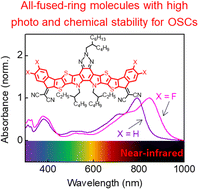All-fused-ring small molecule acceptors with near-infrared absorption†
Abstract
The development of small molecule electron acceptors with near infrared (NIR) absorption has led to great progress in organic solar cells (OSCs). However, the stability is a barrier, limiting the further applications of these small molecule electron acceptors. In this study, using an all-fused-ring strategy, we have developed two NIR-absorbing small molecule electron acceptors, FM3 and FM4, with high stability, which are ADA’DA (A, acceptor; D, donor) structured 12-fused-ring systems. By extending the conjugation to the D fragments and introducing electron-deficient substituents on the A fragments, the band gaps of FM3 and FM4 could be continuously reduced to 1.44 eV and 1.33 eV, respectively, thus causing the absorption redshift to the NIR region. Both FM3 and FM4 exhibited excellent photo, thermal and chemical stability, which was attributed to their all-fused-ring skeletons. Organic solar cells using these molecules as electron acceptors exhibit power conversion efficiencies (PCEs) of 11.4% and excellent device stability. This work indicates that all-fused-ring molecules have a strong potential in the development of NIR-absorbing opto-electronic devices with high stability.

- This article is part of the themed collection: Journal of Materials Chemistry C HOT Papers


 Please wait while we load your content...
Please wait while we load your content...